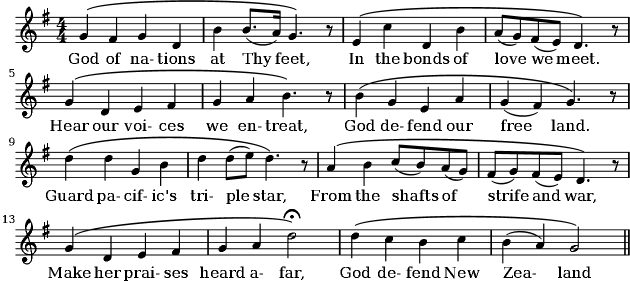Grade Four
| Time | 3 hours |
| Maximum mark | 100 |
| Pass mark | 60 |
Time and rhythm
Added to the note values and rests of the previous grades, entrants will now recognize:Syncopation (crotchet and quaver values only)
Barring an unbarred phrase
Time signatures:

Compound quadruple time
Keys and Scales
- The recognition and writing of scales and their key signatures as for previous grades, with the addition of the following:
~~ B, F♯, D♭ and G♭ major
~~ B, F♯, C♯, F and B♭ minor (harmonic form)
through one or two octaves. - To show a use of double sharps, double flats, tones and semitones and the technical names of the degrees of the scales.
- To recognize diatonic and chromatic semitones in scales.
Intervals
Recognition and writing of all diatonic intervals (both harmonic and melodic) and their inversions in specified keys for the grade. Treble clef or Bass clef.Modulation
Recognition in melodies of modulation to the dominant or relative major or minor.Harmony
- Recognition of chords on I, Ib, II, IIb, IV, IVb, V, Vb, VI, VIb, VIIb in major keys and chords on I, Ib, IIb, IV, IVb, V, Vb, VI, VIb in minor keys up to four sharps or flats, in either pianoforte or four part vocal style
- Writing and recognition of four principal cadences in the same keys in both styles
- The harmonization of a simple melody in major or minor up to four sharps or four flats, not more than 8 bars, in four part vocal style.
Form
To understand the form, time and character of the dances used in baroque keyboard suites (Bach, Handel and Purcell), i.e. Allemande, Courante, Sarabande, Minuet, Gavotte, and Gigue.Instrumental
To show a knowledge of orchestral bowed strings, their tunings, and use of appropriate clefs.General Musical Skills
- To write a melody to a verse couplet with words correctly placed below notes
or - To write a balanced melody to a given rhythm of not more than 8 bars, in a major or minor key up to two sharps or two flats. Phrasing is required. Modulation not expected.
Memory and Transposition
- The entrants will be expected to write "God Defend New Zealand" from memory on the treble stave. The correct key signature, time signature, pitch and note values, and phrasing are expected. Words are not required.

- For Memory Tunes grades 1 to 4 the versions given in the NZMEB Theory syllabus are the versions required for NZMEB Theory Exams.
- Entrants will be expected to transpose a short melody (approx. 8 bars in length) into another key. Accidentals will be included. Keys and note values will be specified for the grade.
Terminology
The English meanings of the following, together with their abbreviations and signs, where applicable: adagio, allegretto, allegro, andante, con moto, grave, largo, largamente, larghetto, lento, l'istesso tempo, moderato, non troppo, prestissimo, presto, tempo commodo, tempo giusto, vivace, vivo accelerando (accel.), allargando, a tempo, meno mosso, piu mosso, rallentando (rall.), ritardando (rit.), ritenuto (riten.) (rit.), rubato, stringendo crescendo (cres.) (cresc.), calando, decrescendo (decres.) (decresc.), morendo, diminuendo (dim.), forte-piano (fp), forte (f), piano (p), sforzando (sf) (sfz), pianissimo (pp), perdendosi, fortissimo (ff), smorzando, mezzo forte (mf), rinforzando (rfz) (rf), mezzo piano (mp), pesante legato, con anima, staccato, con brio, maestoso, con grazia, sostenuto, con forza, sempre, dolce, poco, risoluto, molto, ben marcato, senza, main droite (m.d.), main gauche (m.g.), cantabile, leggiero, una corda, fine, dal segno, tre corde, da capo al fine, ad libitum, mezzo staccato, opus, agitato, attacca, loco, animato, tranquillo, cantando, tenuto (ten), piacevole, portamento, dolente, doloroso, sotto voce, giocoso, grazioso, assai, quasi, scherzando, subito (sub)Terms referring to String Playing
sul ponticello (sul pont), sul tasto, tremolo, pizzicato (pizz), arcoOrnaments
appoggiatura, acciaccatura, mordent (upper and lower), turn, trillAllocation of marks from a total of 100
| Time and Rhythm | 14 |
| Scales and Modulation | 10 |
| Intervals | 12 |
| Cadences and Harmony | 24 |
| Memory and Transposition | 14 |
| Composition | 10 |
| Musical Knowledge | 16 |